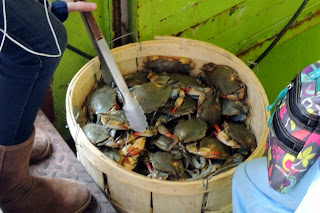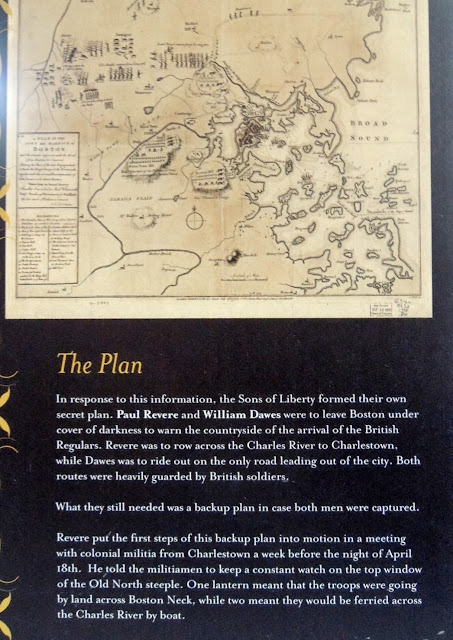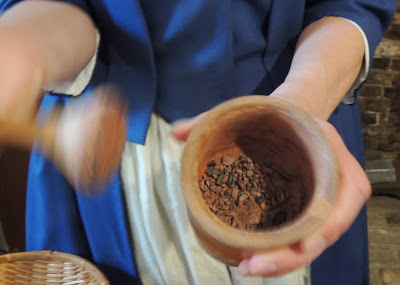I took the Red Line of the T from Davis Square to Government Center (transferring at Park).
I was amazed how immense Government plaza was. It must be a great place for outdoor events.
Then I walked to Haymarket where I met up with friend Jeff and his 17-month-old daughter Jules. Jeff rides his bike to the Friday (and Sat.) Haymarket reduced produce market each week, 45 minutes each way. The stalls are filled with produce (and flowers) that have not been sold that week, and are at greatly reduced prices. It was fun to browse and also see Jeff's favorite vendors, Anthony and others.
 |
| Excess food, waiting to be put out |
 |
| more excess produce |
 | |
| Live tiny crabs |
As Jeff was about to leave, he pointed out the imprints on the street. When it was repaved, memories of spoiled fruit and veggies and broken boxes were put in the street. Cool, eh?
Then Jeff and I said good bye. He headed home and I went north to the North Church area.
On the way, I passed over a beautiful Greenway where people could sit, where concerts were held, etc.
 |
| Birdie getting a drink on the Greenway! |
Here is more information on the Greenway: http://www.rosekennedygreenway.org/
The North Church was made famous during Paul Revere's ride to tell the local residents that the British were coming. I had to memorize Longfellow's poem "Paul Revere's Ride in 5th grade and still remember the beginning. (Revere rode out to warn residents but also others hung lanterns from the North Church tower.) The church was built in 1723 and you can read about it at:
http://oldnorth.com/history-architecture/
The map above shows the area where I then spent more than2 hours. The Gift Shop in the lower right is also by Paul Revere's House.
I walked into the Old North Church in the middle of a short explanation to groups.
 |
| sign posted outside church |
The church is a "working" church, open to the community. It was not always that way. Originally, families paid for boxes in the church and at independence time, I think they cost about 70 pounds each, which is equivalent to $26,000 today, so it was not a place for the poor! It became a more public church in 1912. There is also a crypt below the main floor with 37 tomb and over 1000 bodies buried there including 150 British soldiers.
 | |
| family boxes in the church |
 |
| Inside of church--notice flags |
 |
| organ at back on balcony |
 | ||
| Engraving of the church in first have of 18th century |
The church is famous for the lanterns being hung in its bell town in 1775 to notify the residents that the British were coming to attack. Signs posted inside talked about that history and the history of the church. I hope you can make out the information on the pictures I took of them.
 | |
| Sign on outside wall |
Behind the church is a nice promenade, part of which is called Paul Revere Mall.
I am sorry that the photos are a bit dark. It was overcast in the morning when I visited.
As I walked down the steps behind the church, I saw a piano, part of the street piano (live art) for people to use through the town. Notice the strong cable anchoring the bench. Someone did play later from one of the tourist groups walking by--what a wonderful idea!
To the left is a memorial for soldiers that died in the Afghanistan and Iraq wars. Notice the dog tags hanging behind and around.
Further down is a fountain and a number of plaques about the people of Boston in revolutionary times.
 | |
| Paul Revere mall with signs of history mounted in the wall |
 | |
| Paul Revere Mall Sign |
 | ||
| Sign of important women in the Boston area |
I took these pictures at about 10:30 a.m. as I was looking for the chocolate history museum.
I found out a bit later that this house was the site, but no sign was up to indicate either it or the Print Museum was housed there. The signs went up as they opened at 11.
 |
| Old sign at front of museum under Clough sign |
 |
| The printing office of Edes and Gill |
 | |||
| New sign added this day for Capt Jackson's Historic Chocolate Shop |
Two women in colonial dress worked in the chocolate shop which opened in April and will be open until the end of October. This is its first season. The print shop is in its 3rd season.
I really enjoyed the presentation at the chocolate shop. Although no one else arrived when I did, the woman graciously started her presentation. First she showed how cacao pods grow, directly out of the trunk of the tree. Pods were 9 to 12" in length. It took them 6 months to mature on the trunk of the tree and grew mostly within 20 degrees of the equator. There is another great picture of this in the Wikipedia article at .http://en.wikipedia.org/wiki/Cocoa_bean
 | |||||
| An open cacao pod |
 |
| Nibs on top and shells below |
 |
| "mano" for rolling nibs--very high in fat content. Heater below |
The chocolate then hardens into a big chunk.
 | ||
| Chocolate chunk on left, sugar chunk above |
A combination of 8 spices were added including cinnamon, anise, nutmeg, cayenne, and 4 more.
Hot (but not boiling) water was added to a pot in equal portions to the dried mix. The mixture was then swirled together.
We were given intensely strong tastes of this hot cocoa as cocoa was used primarily as a beverage. (No milk was added. That only came about in the late 1800s. Chocolate bars with milk were invented in about 1870s.)
We were given small amounts but given the intensity, the amount was more than enough. I took little sips and let the delicious liquid sit in my mouth for a bit before swallowing.
I again saw the little dishes that I had seen in the Paul Revere gift shop and decided to buy two to use as Shabbat candle sticks.
I didn't stay for the full presentation at the historic print shop but was there for a few minutes.
After the Declaration of Independence was signed on July 4, 1776, 13 copies were made and sent to each of the 13 colonies. Then each colony printed copies to be sent throughout the colony. The copy arrived in Massachusetts around July 14 and was printed on this Guttenberg style printing machine. You can read more about this 18th century print shop and its influence in colonial times at:
http://bostongazette.org/about/
After I left the area, I walked back toward Haymarket. I walked to a major street (Salem). It was one way and had parking on one side and barely had room for trucks to pass through.
There were lots of shops and restaurants along the way. I was fascinated by a coffee, tea and spice shop with some Syrian spices but my hands were already full so I moved on.
I stopped by the market on the way back. More people were there than two hours before. I saw two new root vegetables I had never seen before.
Jeff said that early on Friday morning the place is heavily populated by restauranteurs.
I was also surprised to see sugar cane and my favorite kind of cucumbers, that I first ate in Israel and can also get at Trader Joe's.
On the way to the T, I stopped at the New England Holocaust memorial. You can read about it at:
http://www.nehm.org/ and read about the history and design of the memorial.
 |
| S |
 |
| Entrance |
 |
| Six Towers, each with 1,000,000 numbers |
 |
| Gratings with names of Concentration camps and steam from T like crematoria |
 |
| Dedication: "I will give them an everlasting name." |
 |
| Niemoeller quote |
 |
| Rocks left in memory and in box to the right |
 |
| Slab at other end of memorial: Shoah is the Hebrew word for the Holocaust |



































